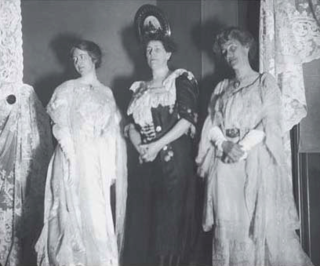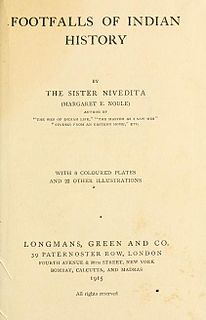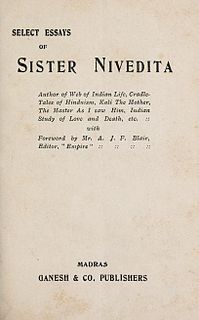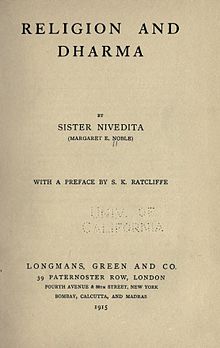Hinduism is the world's third largest religion. It is an Indian religion and dharma, or way of life, widely practised in the Indian subcontinent and parts of Southeast Asia. Hinduism has been called the oldest religion in the world, and some practitioners and scholars refer to it as Sanātana Dharma, "the eternal tradition", or the "eternal way", beyond human history. Scholars regard Hinduism as a fusion or synthesis of various Indian cultures and traditions, with diverse roots and no founder. This "Hindu synthesis" started to develop between 500 BCE and 300 CE, after the end of the Vedic period, and flourished in the medieval period, with the decline of Buddhism in India.

Swami Vivekananda, born Narendranath Datta, was an Indian Hindu monk, a chief disciple of the 19th-century Indian mystic Ramakrishna. He was a key figure in the introduction of the Indian philosophies of Vedanta and Yoga to the Western world and is credited with raising interfaith awareness, bringing Hinduism to the status of a major world religion during the late 19th century. He was a major force in the revival of Hinduism in India, and contributed to the concept of nationalism in colonial India. Vivekananda founded the Ramakrishna Math and the Ramakrishna Mission. He is perhaps best known for his speech which began with the words - "Sisters and brothers of America ...," in which he introduced Hinduism at the Parliament of the World's Religions in Chicago in 1893.

Sister Nivedita was an Irish teacher, author, social activist, school founder and disciple of Swami Vivekananda. She spent her childhood and early youth in Ireland. From her father, a college professor, she learned the ideal of service to mankind as the true service to God. She worked as a school teacher and later also opened a school. She was engaged to marry a Welsh youth, but he died soon after their engagement. Sister Nivedita met Swami Vivekananda in 1895 in London and travelled to Calcutta, India in 1898. Swami Vivekananda gave her the name Nivedita when he initiated her into the vow of Brahmacharya on 25 March 1898. In November 1898, she opened a girls' school in the Bagbazar area of Calcutta. She wanted to educate girls who were deprived of even basic education. During the plague epidemic in Calcutta in 1899, Nivedita nursed and took care of the poor patients. Nivedita had close associations with the newly established Ramakrishna Mission. Because of her active contribution in the field of Indian Nationalism, she had to publicly dissociate herself from the activities of the Ramakrishna Mission under the then president Swami Brahmananda. She was very close to Sarada Devi, the spiritual consort of Ramakrishna and one of the major influences behind Ramakrishna Mission, and also with all brother disciples of Swami Vivekananda. She died on 13 October 1911 in Darjeeling. Her epitaph reads, "Here lies Sister Nivedita who gave her all to India".

Sister Gargi, born Marie Louise Burke, was a writer and an eminent researcher on Swami Vivekananda, and a leading literary figure of the Ramakrishna-Vivekananda movement. Sister Gargi was introduced to the Ramakrishna-Vivekananda movement in 1948 by Swami Ashokananda. She is known for her six-volume work, Swami Vivekananda in the West: New Discoveries. Her New Discoveries are considered as indispensable for Swami Vivekananda research.

The Bhagavad Gita, often referred to as the Gita, is a 700-verse Sanskrit scripture that is part of the Hindu epic Mahabharata.
Swami Swahananda was a senior monk of the Ramakrishna Order of India, and the minister and spiritual leader of the Vedanta Society of Southern California from 1976 to 2012. He also led the Vivekananda Retreat, Ridgely, and the Vedanta Center of Greater Washington, DC. He joined the Ramakrishna Order in 1947 and received sannyasa, full monastic ordination, in 1956.
Pravrajika Vrajaprana is a writer on Vedanta, the history and growth of the Vedanta Societies and a nun at the Vedanta Society of Southern California's Sarada Convent. She is also a well known speaker and scholar on Hinduism and has given talks at several universities and interfaith gatherings. Her works on Vedanta include, Vedanta: A Simple Introduction (1999), editor of Living Wisdom (1994). She is the co-author, with Swami Tyagananda, of Interpreting Ramakrishna: Kali's Child Revisited (2010).

Bhagini Nivedita is a 1962 Bengali film directed by Bijoy Basu. The story was based on the life of Sister Nivedita. It won a national film award in best films category and a presidential medal.

The Web of Indian Life (1904) is a book written by Sister Nivedita. This book is a collection of essays and created a sensation when it was first published. The introduction of the book was written by Rabindranath Tagore.

Josephine MacLeod (1858–1949) was an American friend and devotee of Swami Vivekananda. She had a strong attachment to India and was an active participant in the Ramakrishna Vivekananda movement. She was given the nicknames "Tantine" and "Jo Jo" by Vivekananda. She considered Swami Vivekananda to be her friend and helped him with his finances. She and Sister Nivedita exchanged letters discussing their positive impressions of Swami Vivekananda and they competed with each other for his attention. Josephine was not a sanyasin, unlike many others such as Sister Nivedita or Sister Christine. She was instrumental in spreading Vivekananda's message on Vedanta in the West. She had many contributions to the initial and the later phases of the development of the order of Ramakrishna and Vivekananda. She was a contributor to many causes espoused by Sister Nivedita, the most famous disciple of Vivekananda, including that of contributing financially towards the development of Indian National Movement esp. in Bengal and elsewhere in India.

Cradle Tales of Hinduism (1907) is a collection of stories by Sister Nivedita. It is an introduction to Hindu mythology; the stories come from the Mahabharata, the Ramayana and other Hindu sources and are presented as they were told in Indian nurseries.

Footfalls of Indian History (1915) is a book written by Sister Nivedita. Nivedita dedicated her life for the service of India. In the book the author has discussed on several chapters of Indian history about its glory and drawbacks. The most important topics of Indian history like religions of India, Indian philosophy, Indian culture, and Indian architecture have been discussed in the book. Nivedita not only discussed some problems in India, she also suggested ways to solve some of those problems.

An Indian Study of Love and Death (1908) is a book written by Sister Nivedita.

Myths of the Hindus & Buddhists (1913) is a book written by Sister Nivedita and Ananda K. Coomaraswamy.

Studies from an Eastern Home (1913) is an autobiographical book written by Sister Nivedita.

Notes of Some Wanderings with the Swami Vivekananda (1913) is an English language book written by Sister Nivedita. In this book Nivedita has narrated the experiences she had while traveling with Swami Vivekananda in different parts of India.

Select Essays of Sister Nivedita (1911) is an English-language book written by Sister Nivedita, a disciple of Swami Vivekananda. The foreword of the book was written by A. J. F. Blair.

Swami Vivekananda (1863–1902) was an Indian Hindu monk and a key figure in the introduction of Indian philosophies of Vedanta and Yoga to the western world. He was one of the most influential philosophers and social reformers in his contemporary India and the most successful and influential missionaries of Vedanta to the Western world. Indian Nobel laureate poet Rabindranath Tagore's suggested to study the works of Vivekananda to understand India. He also told, in Vivekananda there was nothing negative, but everything positive.

Swami Vivekananda represented India and Hinduism at the Parliament of the World's Religions (1893). This was the first World's Parliament of Religions and it was held from 11 to 27 September 1893. Delegates from all over the world joined this Parliament. In 2012 a three-day world conference was organized to commemorate 150th birth anniversary of Vivekananda.

Swami Vivekananda, the 19th-century Indian monk, came to Los Angeles, California in 1899 during his second visit to the West. His oratorical skills and presentation of Hindu religious tenets and comparison with other religious beliefs made him a celebrity among a wide spectrum of American audience. Between 1893—1897 and 1899—1902, he traveled widely in the US lecturing on a wide range of subjects and also established Vedanta Centers. There are such centers in many cities in the US including many centers in California. In 1899, after delivering lectures in New York, he travelled to the western part of United States and reached Los Angeles via Chicago. He then went on to deliver lectures in California at Oakland, San Francisco and Alameda.

















